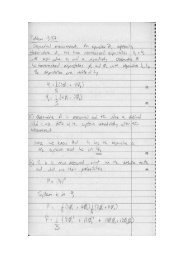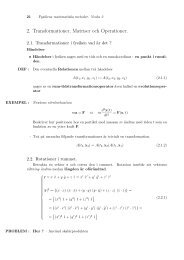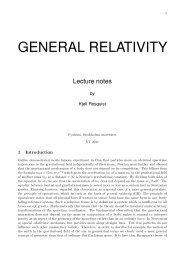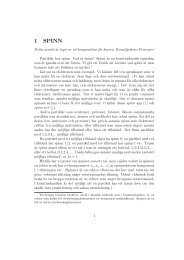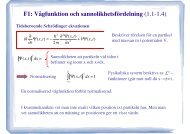You also want an ePaper? Increase the reach of your titles
YUMPU automatically turns print PDFs into web optimized ePapers that Google loves.
<strong>Preon</strong> <strong>physics</strong> <strong>at</strong> <strong>LHC</strong><br />
Philippe Mermod<br />
1
• Dark m<strong>at</strong>ter<br />
• Unific<strong>at</strong>ion<br />
• Hierarchy<br />
SM problems and weaknesses<br />
• Neutrino masses<br />
• M<strong>at</strong>ter/Antim<strong>at</strong>ter Ass.<br />
• Gravit<strong>at</strong>ion<br />
• Elementary particles :<br />
! Too many<br />
! Unstable<br />
! Unpredictable masses<br />
! Oscill<strong>at</strong>ions/mixing<br />
! Charge quantiz<strong>at</strong>ion<br />
! Lepton and baryon number conserv<strong>at</strong>ion<br />
" W and Z are massive<br />
! Higgs still escapes detection<br />
2
Possible remedy : composite leptons,<br />
• Dark m<strong>at</strong>ter<br />
quarks and vector bosons<br />
# preon stars and new neutrinos<br />
• Unific<strong>at</strong>ion<br />
# no fundamental weak force<br />
• Hierarchy<br />
# no higgs mechanism<br />
• Neutrino masses<br />
# neutrinos are composite<br />
• M<strong>at</strong>ter/Antim<strong>at</strong>ter Ass.<br />
# as many preons as antipreons<br />
• Gravit<strong>at</strong>ion<br />
• Elementary particles :<br />
! Too many<br />
# 3 preons<br />
! Unstable<br />
# rearrangement among preons<br />
! Unpredictable masses<br />
# preon dynamics ?<br />
! Oscill<strong>at</strong>ions/mixing<br />
# same net preon flavour<br />
! Charge quantiz<strong>at</strong>ion<br />
# only 1/3e and 2/3e<br />
! Lepton and baryon number conserv<strong>at</strong>ion<br />
# explained but can be broken<br />
$ W and Z are massive<br />
# preon-antipreon st<strong>at</strong>es<br />
3
<strong>Preon</strong>-trinity model<br />
J.-J. Dugnes, S. Fredriksson and J. Hansson,<br />
Europhys. Lett. 60, 188 (2002)<br />
• Three preons in total<br />
• They can form tight dipreon pairs<br />
• Lepton = preon + dipreon<br />
• Quark = preon + anti-dipreon<br />
• Vector boson = preon + anti-preon<br />
• The model is qualit<strong>at</strong>ive, it still lacks a dynamics<br />
4
Model predictions (1)<br />
• One new charged heavy lepton<br />
• Two new neutrinos<br />
• Three new heavy quarks (one with charge 4/3)<br />
• Two new heavy vector bosons<br />
• Good sign : the top quark is among the super-heavies<br />
(with isol<strong>at</strong>ed !)<br />
5
• No Higgs boson<br />
Model predictions (2)<br />
• The third oscill<strong>at</strong>ing neutrino is not the ! " :<br />
instead it is a new one, which does not couple to<br />
the Z<br />
• The top quark decay involves a new heavy<br />
• ...<br />
vector boson<br />
6
The neutrino front<br />
• Neutrino masses and oscill<strong>at</strong>ions easily<br />
explained in the model<br />
• On the CNGS beam, experiments like OPERA<br />
plan to measure directly " leptons from ! "<br />
interactions " not expected to happen in the<br />
preon model !<br />
7
Tev<strong>at</strong>ron and <strong>LHC</strong> front<br />
• New exotic heavy particles<br />
• New exotic decay channels<br />
• Richer top sector<br />
• Lepton and quark excited st<strong>at</strong>es<br />
• New interpret<strong>at</strong>ion in case of non-discovery of<br />
Higgs<br />
8
• # + lepton :<br />
New heavy lepton<br />
– Very weak production <strong>at</strong> hadron colliders<br />
– Decay involves very hard single #$%&'( with very large MET<br />
and no jets<br />
9
• t quark :<br />
Heavy quark decays<br />
– Decay involves a W' (which in turn might decay into W +<br />
neutrinos)<br />
• e, $ and " are not on the same footing<br />
• can try to reconstruct the W' invariant mass if lighter than<br />
the top mass<br />
– New decay mode involving a Z*<br />
• specific sign<strong>at</strong>ure : 1 hard jet (not a b-jet) + large MET<br />
• h and g quarks :<br />
– Same decays as t, but with no b-jets<br />
10
Summary<br />
• The preon trinity model can qualit<strong>at</strong>ively<br />
explain all fe<strong>at</strong>ures of the SM<br />
• It solves many problems of the SM<br />
• It predicts new <strong>physics</strong> which are expected to<br />
show up <strong>at</strong> <strong>LHC</strong><br />
11
Outlook<br />
• The model can easily be killed (Higgs<br />
discovery, OPERA experiment, refined top<br />
decays)<br />
• We can produce a paper on potential<br />
sign<strong>at</strong>ures <strong>at</strong> <strong>LHC</strong><br />
• If devi<strong>at</strong>ions from SM are seen, they might be<br />
interpreted in terms of compositeness<br />
12


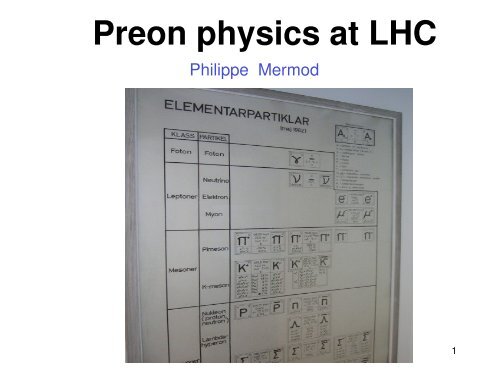
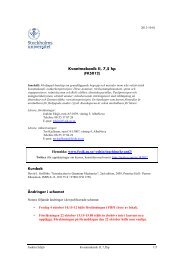
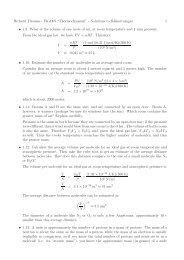
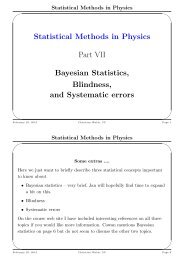
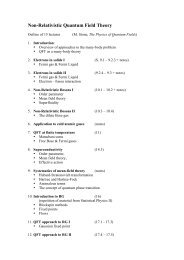
![Final Examination Paper for Electrodynamics-I [Solutions]](https://img.yumpu.com/21085948/1/184x260/final-examination-paper-for-electrodynamics-i-solutions.jpg?quality=85)

